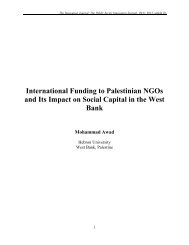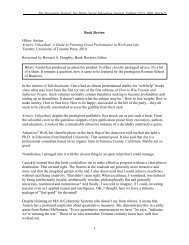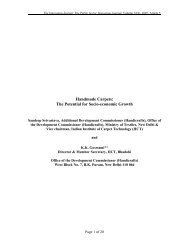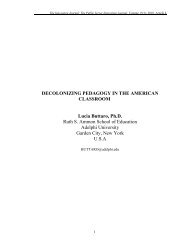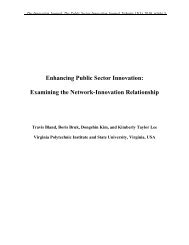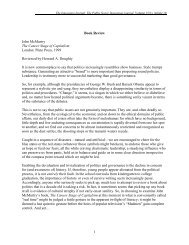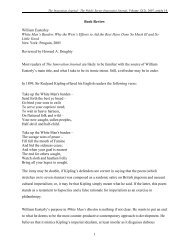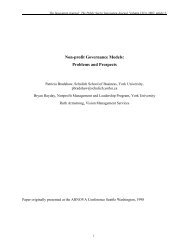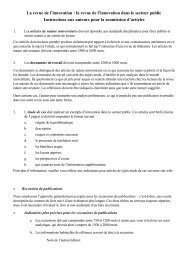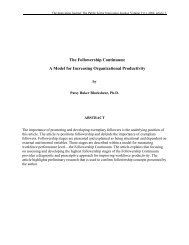Trade Corridor Transparency and Security - The Innovation Journal
Trade Corridor Transparency and Security - The Innovation Journal
Trade Corridor Transparency and Security - The Innovation Journal
Create successful ePaper yourself
Turn your PDF publications into a flip-book with our unique Google optimized e-Paper software.
<strong>The</strong> <strong>Innovation</strong> <strong>Journal</strong>, Volume 8 (4), 2003<br />
4. Giving the UCR II identifier a special Internet “presence”, i.e. a cross between an<br />
always-on IP address <strong>and</strong> the “presence awareness” features of instant messaging<br />
addresses.<br />
5. Cooperative installation of an international secure “spine” network to contain the<br />
communications that locate – <strong>and</strong> can examine inside a virtual file – all messages <strong>and</strong><br />
other commercial documents that bear a common UCR II transaction identifier,<br />
i.e. the Internet of commercial <strong>and</strong> trade documentation.<br />
UCR II imagines that it would be possible to secure cooperation among governments<br />
who form a sufficient critical mass so that these measures in due course could become<br />
global. It imagines that participating governments <strong>and</strong> private holders of key intellectual<br />
properties could find the basis for the necessary private-public partnerships. <strong>The</strong> goal<br />
imagines that billions in private <strong>and</strong> public investments could be agreed <strong>and</strong> coordinated<br />
in a comparatively short time period. It imagines that U.S. unilateral requirements for<br />
heightened security could merge successfully with a multilateral re-engineering of<br />
business processes intended in part to satisfy other public <strong>and</strong> private objectives. And<br />
finally, the UCR II vision imagines that public <strong>and</strong> private participants could devise,<br />
reach international agreement on <strong>and</strong> deploy the layered <strong>and</strong> nested set of<br />
communications, security <strong>and</strong> accountability protocols required for a secure “spine”<br />
network.<br />
<strong>The</strong> first inclination will be to label this UCR II vision as an impossible fantasy. Yet is<br />
this really the case? How much is already under way or will have to be launched in any<br />
case in response commercial need <strong>and</strong> to U.S. imperatives? <strong>The</strong> UCR II vision contains<br />
some elements of invention <strong>and</strong> transformation, but mainly it provides a holistic insight<br />
that integrates <strong>and</strong> harmonizes the energies of current re-engineering <strong>and</strong> investment<br />
decisions – a proverbial joining of the dots already present in the environment. <strong>The</strong><br />
11 factors reviewed below indicate that substantial portions of the 5 pillars for UCR II<br />
already exist or are coming into being.<br />
1. Corporate identity: Current governmental practice within national public record<br />
systems is to assign multiple identifiers to any resident corporation. Multiple<br />
corporate pseudonyms are anathema to the good operation of automated,<br />
instantaneous, global transaction systems, i.e. the much forecast but yet-to-emerge e-<br />
commerce world. Such ambiguity is significantly out of step in an environment that<br />
is moving rapidly toward unique identifiers on all manufactured items (to create an<br />
Internet of things) <strong>and</strong> dem<strong>and</strong>s that the uniqueness <strong>and</strong> risk factors of personal<br />
identities be supported by regular criminal background checks, substance abuse tests<br />
<strong>and</strong> by photographs, fingerprints <strong>and</strong> other biometric markers. Unlike C-TPAT, CSI<br />
<strong>and</strong> FAST, unification of corporate identities would place the same 'burden of change'<br />
on the US government <strong>and</strong> US companies as is now imposed on the rest of the world.<br />
2. Resources: <strong>The</strong> decisions of BCP, a single US agency, to meet comparatively narrow<br />
goals have triggered a first round of re-engineering costs in the global trade system<br />
that is likely to exceed $10-$12 billion over the next decade. Further BCP dem<strong>and</strong>s<br />
11



